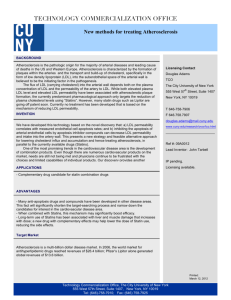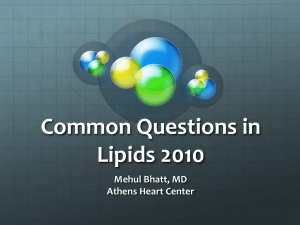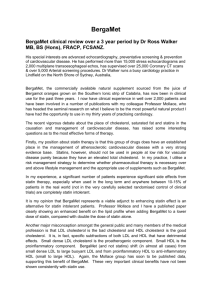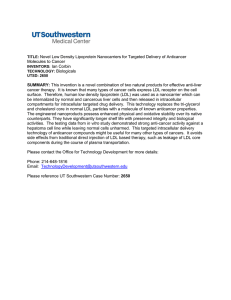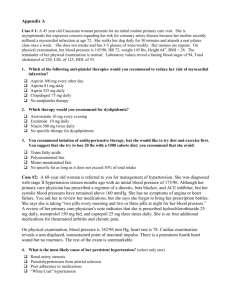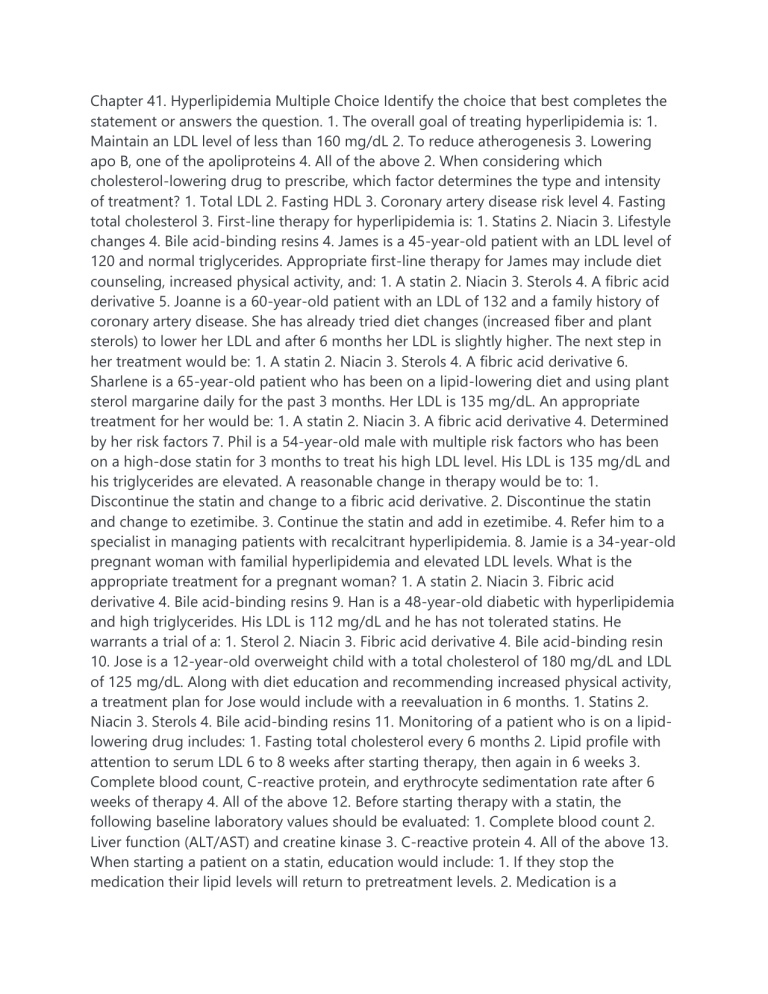
Chapter 41. Hyperlipidemia Multiple Choice Identify the choice that best completes the statement or answers the question. 1. The overall goal of treating hyperlipidemia is: 1. Maintain an LDL level of less than 160 mg/dL 2. To reduce atherogenesis 3. Lowering apo B, one of the apoliproteins 4. All of the above 2. When considering which cholesterol-lowering drug to prescribe, which factor determines the type and intensity of treatment? 1. Total LDL 2. Fasting HDL 3. Coronary artery disease risk level 4. Fasting total cholesterol 3. First-line therapy for hyperlipidemia is: 1. Statins 2. Niacin 3. Lifestyle changes 4. Bile acid-binding resins 4. James is a 45-year-old patient with an LDL level of 120 and normal triglycerides. Appropriate first-line therapy for James may include diet counseling, increased physical activity, and: 1. A statin 2. Niacin 3. Sterols 4. A fibric acid derivative 5. Joanne is a 60-year-old patient with an LDL of 132 and a family history of coronary artery disease. She has already tried diet changes (increased fiber and plant sterols) to lower her LDL and after 6 months her LDL is slightly higher. The next step in her treatment would be: 1. A statin 2. Niacin 3. Sterols 4. A fibric acid derivative 6. Sharlene is a 65-year-old patient who has been on a lipid-lowering diet and using plant sterol margarine daily for the past 3 months. Her LDL is 135 mg/dL. An appropriate treatment for her would be: 1. A statin 2. Niacin 3. A fibric acid derivative 4. Determined by her risk factors 7. Phil is a 54-year-old male with multiple risk factors who has been on a high-dose statin for 3 months to treat his high LDL level. His LDL is 135 mg/dL and his triglycerides are elevated. A reasonable change in therapy would be to: 1. Discontinue the statin and change to a fibric acid derivative. 2. Discontinue the statin and change to ezetimibe. 3. Continue the statin and add in ezetimibe. 4. Refer him to a specialist in managing patients with recalcitrant hyperlipidemia. 8. Jamie is a 34-year-old pregnant woman with familial hyperlipidemia and elevated LDL levels. What is the appropriate treatment for a pregnant woman? 1. A statin 2. Niacin 3. Fibric acid derivative 4. Bile acid-binding resins 9. Han is a 48-year-old diabetic with hyperlipidemia and high triglycerides. His LDL is 112 mg/dL and he has not tolerated statins. He warrants a trial of a: 1. Sterol 2. Niacin 3. Fibric acid derivative 4. Bile acid-binding resin 10. Jose is a 12-year-old overweight child with a total cholesterol of 180 mg/dL and LDL of 125 mg/dL. Along with diet education and recommending increased physical activity, a treatment plan for Jose would include with a reevaluation in 6 months. 1. Statins 2. Niacin 3. Sterols 4. Bile acid-binding resins 11. Monitoring of a patient who is on a lipidlowering drug includes: 1. Fasting total cholesterol every 6 months 2. Lipid profile with attention to serum LDL 6 to 8 weeks after starting therapy, then again in 6 weeks 3. Complete blood count, C-reactive protein, and erythrocyte sedimentation rate after 6 weeks of therapy 4. All of the above 12. Before starting therapy with a statin, the following baseline laboratory values should be evaluated: 1. Complete blood count 2. Liver function (ALT/AST) and creatine kinase 3. C-reactive protein 4. All of the above 13. When starting a patient on a statin, education would include: 1. If they stop the medication their lipid levels will return to pretreatment levels. 2. Medication is a supplement to diet therapy and exercise. 3. If they have any muscle aches or pain, they should contact their provider. 4. All of the above 14. Omega 3 fatty acids are best used to help treat: 1. High HDL 2. Low LDL 3. High triglycerides 4. Any high lipid value 15. When are statins traditionally ordered to be taken? 1. At bedtime 2. At noon 3. At breakfast 4. With the evening meal 16. Which the following persons should not have a statin medication ordered? 1. Someone with 3 first- or second-degree family members with history of muscle issues when started on statins 2. Someone with high lipids, but low BMI 3. Premenopausal woman with recent history of hysterectomy 4. Prediabetic male with known metabolic syndrome 17. Fiber supplements are great options for elderly patients who have the concurrent problem of: 1. End-stage renal failure on fluid restriction 2. Recurrent episodes of diarrhea several times a day 3. Long-term issues of constipation 4. Needing to take multiple medications around the clock every 2 hours 18. What is considered the order of statin strength from lowest effect to highest? 1. Lovastatin, Simvastatin, Rosuvastatin 2. Rosuvastatin, Lovastatin, Atorvastatin 3. Atorvastatin, Rosuvastatin, Simvastatin 4. Simvastatin, Atorvastatin, Lovastatin
